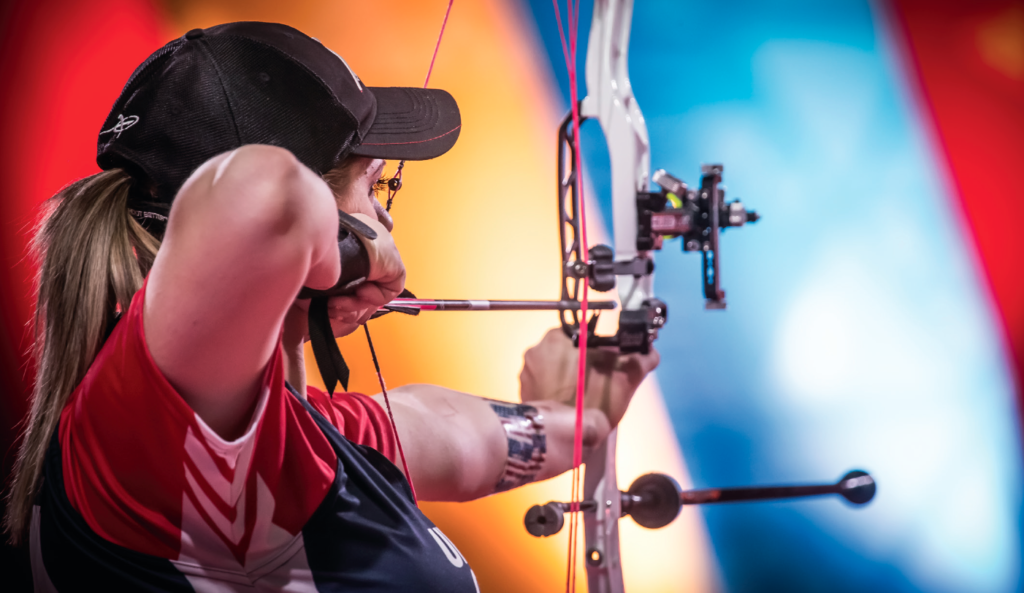
Forget the anecdotal evidence – we’ve run the numbers. By Ferdinand Wegrostek and Bernd Kolmanz
For indoor shooting (e.g. WA 18) the use of thicker arrow shafts instead of thinner ones is discussed again and again. Do thicker arrows really bring a significant score point gain?
The advantage of thicker arrows for the short indoor distance of 18m can be explained pragmatically: thicker arrows on the small 40cm target face result in additional score points because they cover a larger area than the ‘normal’ arrows (thinner arrows) and thus more frequently touch the boundary line to the next higher ring.
Opinions differ as to how many additional points can be gained with the thicker arrow shafts. Often it is argued with personal experience. Some think they have seen a clear increase in points with thicker arrows, others can’t tell the difference.
Thus the general question still remains: how many more points do the thicker arrows bring in comparison to the normal thinner arrows on the indoor distance of 18m?
It is interesting to note how the increased score is achieved. Possible interactions with the modified tuning, material, etc. are not taken into account– this would be too complex a task.
But it is surely helpful for the archer and his decision whether or not to use thicker arrows, if one knows the purely area-related effect of thicker arrow shafts on the score more exactly. Here, we will try and show you what we mean.
Applied calculation models
All questions raised above can only be answered with methods of mathematics, statistics and stochastics. The calculations themselves required the use of two complex computer applications. The calculation model according to James Park, i.e. the algorithmic approach for the prognosis model, is based on a Rayleigh probability distribution.
All parameters such as shot distance, target face and arrow-shaft diameter are linked to each other via the Archery Skill-Level-Index (ASL) according to Mr. Park’s calculation model. Secondly, we have used the calculation model of B. Kolmanz.
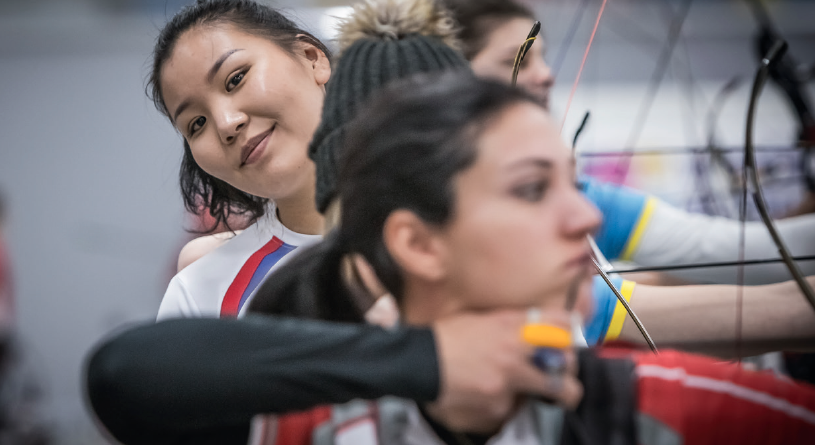
This is a novel and interesting approach to determine score probabilities for a defined number of arrows. It allows us to compare the chances of winning for two archers. We have assumed that thin (‘normal’) arrows are 5mm diameter, and ‘thick’ arrows are 9mm diameter, close to the World Archery maximum. Faces are 40cm, with compound faces using the regular 2cm inner ring.
Considered ring radii for ring ‘inside’ and ‘ring touched’; for both recurve and compound target faces , the ring radii were divided into the ring ‘inner area’ and the area ‘ring touched’. The hit probabilities were calculated for these radii.
Recurve findings
Th e graph shows the WA 18 scores for archery skill levels between 120 and 50 – for thick (9mm) and thin arrows (5mm).
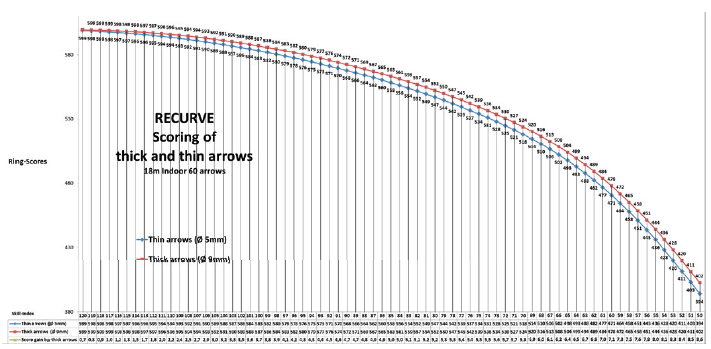
Example:
A shooter is currently using 5mm diameter arrows for the 18m indoor distance. His training level is an average of 580 points with 60 arrows. How would thick arrows with a diameter of 9mm have scored? We look for the value 580 on the line ‘thin arrows’.
The line below shows the score when using thick arrows: 584. So if the shooter would shoot 9mm arrows instead of his 5mm arrows, he would get 584 points, that is 4 (exactly, 3.9) points more on average.
If one looks at the calculated curves, two questions arise:
- How are the increased points gained in detail? Which rings win, and which lose?
- Why does the score gain increase with decreasing skill.
How are the increased points gained? Let’s fi rst look at the average score probability distribution for thin and thick arrows at an advanced performance level (Archery Skill Level 72; FITA 1104).

For all rings from six to ten the probabilities of hitting the ring lines (“touched”) are as expected higher for the thick arrows, but the following inner ring area is hit less oft en by the thick arrows than by the thin arrows.
This applies to all rings from 6-9. Only the 10 ring is an exception and the big ‘winner’ for the thick arrows, because it takes us over the line touch probability at the border to 9, but does not have to give up any score points (there is no 11 ring, in WA competition at least.)
Conclusion
Contact gains at the boundary lines are at the same time ‘losing’ points of the underlying ring. The seven ring wins points by touching hits of its outer ring border (to the six ring), but ‘gives’ again score points to the eight by touching the eight ring, etc. This propagates to the ten ring, which itself cannot lose any score points, but wins ring touches between 9 and 10 rings (plus the balance of the underlying rings).
Since the probability of hitting the target (density) increases with the experienced, good and very good shooter, more score points are given to the higher ring than are won by the rings below.
Last but not least, this means that above a skill level of 72 (FITA 1104 rings), the increase in score points comes solely from increased ten line touches.
More points for lesser archers
Let us look at the probability distribution and the score gain over the rings with an archery beginner (ASL 50).

The overall score gain with thick arrows is greater for beginners (8.58) than for very good archers with an ASL of 72 (see previous table: 5.65 score gain).
There are two reasons for this. First of all, not only the ten ring, but also the nine ring contributes to the point gain of the thick arrows. The nine ring wins score points (3.74) by the shifted hit density on the eight ring and the wider scatter.
The second reason, which contributes to the higher scores with thick arrows, is the reduction of the miss rate for thick arrows from 16.2% to 15.1% (=1 miss for 86 arrows less). In score points this means 26 BOW four score points of all 8.58 gained score points can be attributed to the lower miss rate with thick arrows.
Conclusion
With decreasing skill, archers profit more from the thick arrows, partly because the probability of a miss is reduced. This has a special effect on weaker shooters due to the small target face of 6-10 rings and explains almost half of the point gain by the thick arrows compared to the thin arrows.
Are thick arrows worth it for recurve?
The following table gives the answer:
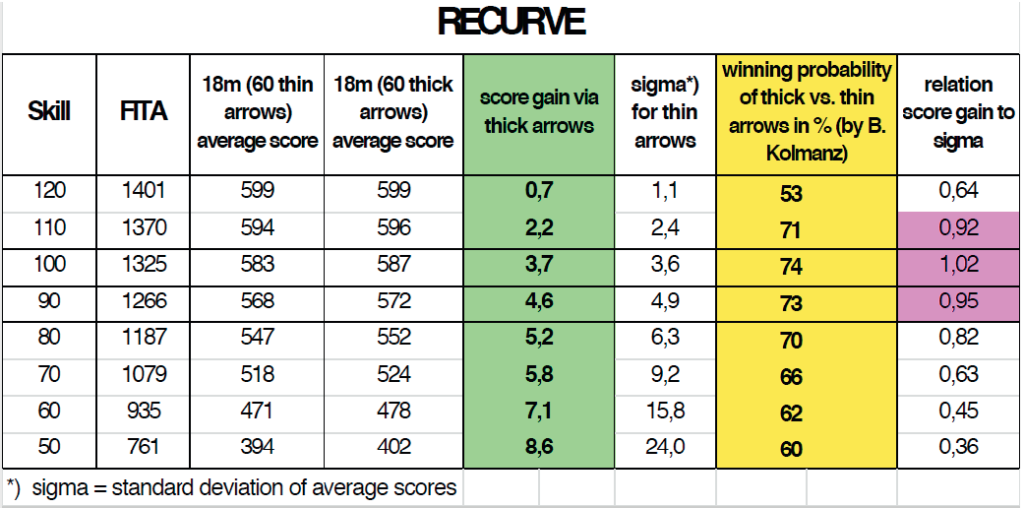
The score gain from thick arrows is to be considered rather small, because it is equal to or within the 68% fluctuation range of a shooter (daily conditions, etc.), i.e. within the majority of his normal skill variation. This is reflected in the ratio of the score gain with thick arrows to the sigma (standard deviation of the score mean values), which is mostly less than 1.
Only in the skill range 90-110 (FITA 1266-1370) there is still an approximate 1:1 ratio (0,95, 1,02, 0,92). Here the chances of winning are a little over 70%, the highest of all skill levels. However, an approximately 70% winning chance with thick arrows is not really high, as there is still a 30% losing chance against the thin arrows or scoring a draw.
We have seen that a high score point gain with thick arrows does not necessarily mean a higher chance of winning. The following two examples out of the calculation model of B. Kolmanz show it significantly. The decisive factor is the score standard deviation, which also expresses the skill level of the archer.
The chances of winning with thicker arrows are at a skill level of 60 (FITA performance of 935 rings; 18m/thin arrows: 471 rings) with 61.9% only slightly over 50% (see table, last row) as would be the case with a coin toss. The other 38.1% are equal (1.7%) or gain (36.4%) of the thin arrows.
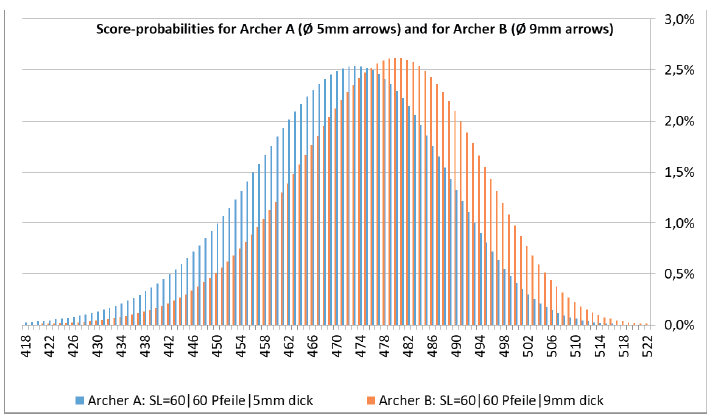
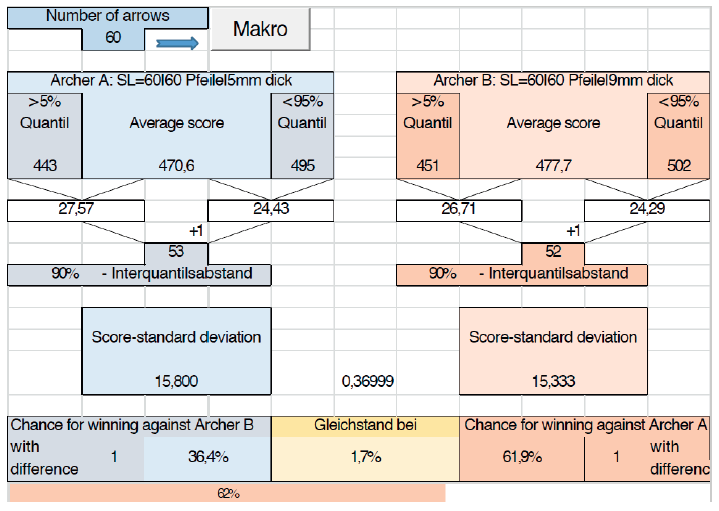
The graph shows also the high overlay of score probabilities for the thin and thick arrows. This is the reason why the advantage of the thick arrows for the archers is practically not noticeable.
The mean values of the scores 470.6 for thin arrows and 477.7 for thick arrows are far apart, namely 7.1 score points (= score gain through thick arrows ), but the score scatter is wide at this weaker performance level (over 15 score points), which considerably reduces the chances of winning the thicker arrows compared to the thinner arrows, namely to (only) 61.9%.
Conclusion
Weaker archers under an ASL of 60 (470 rings with thin arrows at 18m) have only a small chance of winning with thick arrows (less than 62%) compared to thin arrows. Thus thicker arrows for this performance class on 18m bring practically no advantages. With a skill of 100 (FITA level of 1325 rings) the chance of winning is highest with thick arrows.
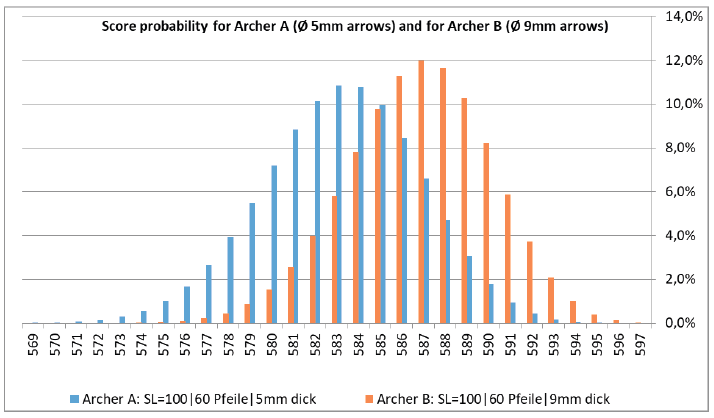
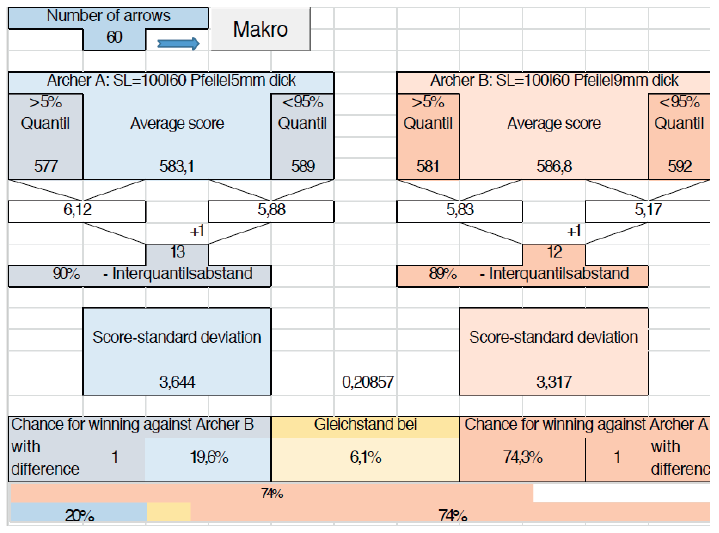
Although both distributions of the score probabilities overlap, they
are somewhat further apart than the previously shown low skill level
of 60.
The score averages are 583.1 for thin arrows and 586.8 for thick arrows. The score gained with thicker arrows is therefore 3.7. The shot spread for this skill is somewhat smaller (σ=3.6; 3.2). This ultimately results in the highest chance of winning 74.3% for the thick arrows for recurve shooters.
Conclusion
For the recurve archer, thicker arrows can produce point gains, but they are usually within his skill range. Thus the point gains are also subjectively not ascertainable.
The chances of winning for thick arrows are highest in the skill range 90 -110 (FITA level 1266 to 1370), i.e. with very good archers, with a little over 70% (30% winning chance for thin arrows or equal chance), but still moderate. The archer with a lower performance does not get a noteworthy benefit from thicker arrows.
Compound findings

For compound shooters the highest score point gains are achieved with thick arrows, i.e. over 5.5 score points, for the very good shooters with a performance of approx. 560 to 586 (with thin arrows) on the 18m indoor distance. But even the very best shooters with scores from 587 to 592 win many additional score points (5.3 to 4) with the thick arrows.
This is the effect of the smaller 10mm ring and wider 9mm ring on the 40mm target face for compound shooters. The score point wins, and the chances of winning the thick arrows against the thin arrows can be read for the thick arrows from the following table for different skill levels.
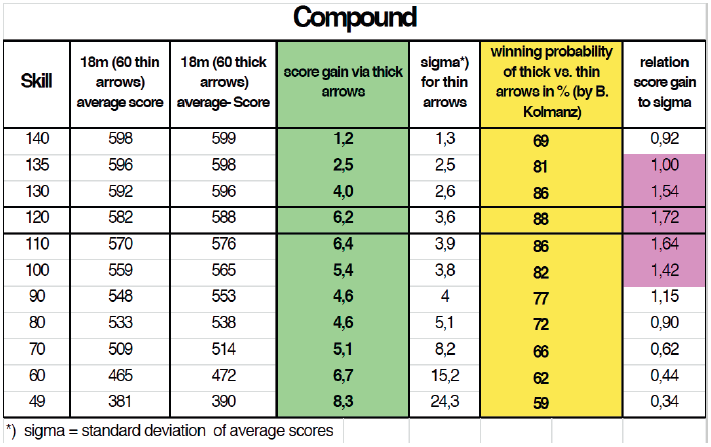
If a shooter shoots a WA18 many times with the Archery Skill Level (ASL) of 120, alternating once with thin arrows and then with thick arrows, 582 points for thin arrows and 588 points for thick arrows can be expected on average over all WA18s, i.e. 6.2 rings more.
Note that this is the average of all WA18 results for thin and once for thick arrows. De facto it can/will happen due to the ‘skill’ variation that the WA18 score is sometimes higher with thin arrows than with thick arrows, i.e. the WA18 has won with thin arrows compared to the WA18 with thick arrows.
How often thick arrows win over thin arrows is answered by the column of odds. The differences to 100% are the chances of winning for the thin arrows and the score balance between both shaft thicknesses.
The chances of winning are reflected in the ratio of score gain to standard deviation of the score mean values (sigma): the higher the score gain due to thick arrows above the sigma, the higher the chance of winning with thick arrows. With a skill of 120 it is highest (1.72).
Below are the graphical distributions of the score probabilities for thin and thick arrows for a very good compound bow shooter with an ASL of 120 (graph and table according to Bernd Kolmanz).
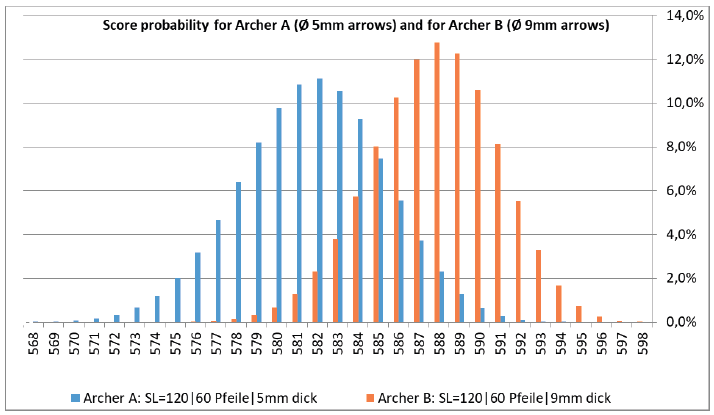
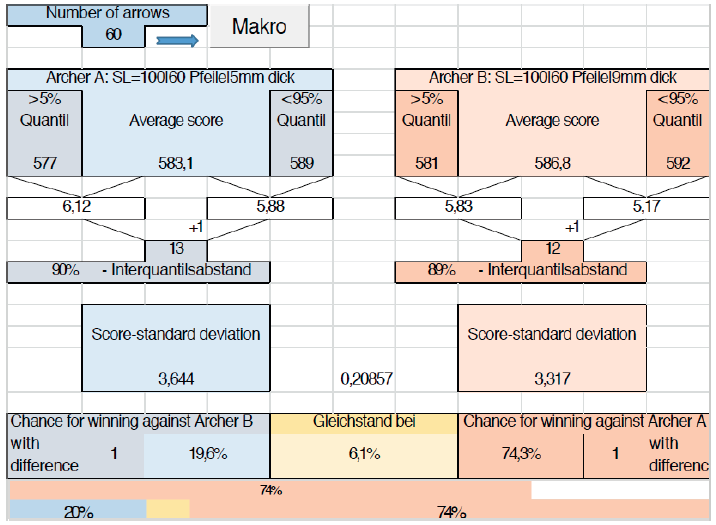
Both distributions overlap only slightly. Th e score standard deviation is small at 3.6 and 3.1, respectively, but the gain with thick arrows is large, namely 6.1 score points. Th e ratio of score gain to sigma is highest at 1.72. This results in a high probability of winning with thick arrows compared to thin of 88%.
Thick arrows will give compound shooters within this performance range a distinct competitive advantage. However, compound shooters with an ASL of 60 and below show a high error dispersion (standard deviation: 15.2 / 14.7) and thus overlap of both score-probability distributions.
Despite an average high score gain of 6.7 points, the chance of winning with thick arrows is only 61%, just 11% above the 50%, and therefore low. It doesn’t pay off to change to thicker arrows at a low performance standard.
Conclusion
The results of the compound shooting tests are different from those of the recurve shooter: good and very good compound shooters with performances of more than 550 and especially more than 560 points on a WA18 benefit with thick arrows more score points than 68% of their scoring/skill variation would allow.
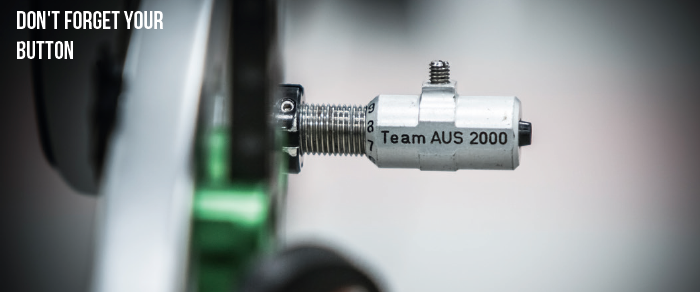
Here the advantage of the larger shaft cross section exceeds the personal performance variance. The chances of winning between the performance levels 570 to 596 increase to over 80% compared to the use of thin arrows.
So very advanced compound shooters are indeed recommended to use shaft thicknesses of 9mm in tournaments. Otherwise they would be at a technical and score disadvantage compared to competing.
For subscriptions to Bow International, please visit https://www.myfavouritemagazines.co.uk/


This is a great article. I hope Bow International would do more of these statistical analysis. I would be interested in how bounce outs from hitting your arrow changes these finding. If you are using thick arrows and score high, then I imagine that the chances of a bounce out also increases, lowering the advantage a bit more.